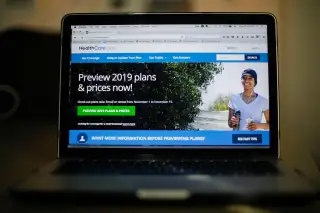The Deadline to Sign Up for Obamacare Is Today. Here's What's New and Why You Should Start Now

Today is the last day to enroll in Obamacare coverage for 2019.
Roughly 11 million Americans have individual or family plans through healthcare.gov or their state exchange, and if you’re one of them and you do nothing, you’ll be automatically renewed into your current health plan. If you're a new customer and you don’t enroll by the Dec. 15 deadline, you’ll be shut out of the market and unable to buy Obamacare coverage for 2019 unless you move, have a baby, or experience other events that will qualify you for a special enrollment period.
This deadline remains unchanged after a federal judge in Texas ruled that the entire Affordable Care Act was unconstitutional. The head of the centers for medicare and medicaid services, which administers the Affordable Care Act, confirmed late Friday that the law remains in effect.
Some states running their own exchanges have set a later deadline for enrolling in coverage for 2019, but in these cases you may still need to enroll by Dec. 15 if you want your coverage to start on Jan. 1. 2019.
Leave Yourself Time
Even if you’re happy with your current coverage, you should still check out what else is available in your area. And while you technically have until midnight Pacific Time (or 3am Eastern Time) to sign up, don’t wait until the last minute. You’ll want to leave plenty of time for remembering your log-in, estimating your income for 2019 to determine your premium subsidy (if eligible), waiting on hold for customer service if you encounter a glitch -- and course, for comparing your plan options.
“Frequently, a person can save a lot of money by shopping around, and that takes more than 15 minutes,” says Dan Mendelson, founder of Avalere Health, a Washington, D.C.-based consultancy.
In fact, an estimated 27% of uninsured people who could shop on the health insurance marketplace, or 4.2 million people nationwide, are eligible to purchase a bronze-level plan with $0 premiums after subsidies in 2019, according to a recent analysis by the Kaiser Family Foundation.
While the comparison-shopping process is similar to prior years, one big change from last year is that you’re no longer required to have health insurance. Starting in 2019, the penalty attached to the individual mandate — the official name for the government requirement that you buy insurance — goes down to $0, so in effect it goes away.
But it’s still a smart move to buy coverage, if you can afford it. Going uninsured leaves you exposed to catastrophic bills if you get into a serious accident or receive a grave diagnosis. If you have such bad luck, you won’t be able to sign up for coverage right away—you’ll have to wait until open enrollment next fall to sign up for coverage that begins Jan. 1, 2020.
Former president Barack Obama—architect of the Affordable Care Act, the 2010 law that created his namesake insurance—took to Twitter this week to remind young people in particular that it’s a good idea to get covered, and that deadline to do so is coming up.
Beware Short-Term Plans' Limitations
Enrollment on the exchanges is down around 11% this year, compared to this time last year. Several factors are behind the decline: the loss of the individual mandate penalty, the Trump administration’s reduction of the open enrollment advertising and outreach budget, and the expansion of short-term plans that are siphoning off customers from the more comprehensive Obamacare coverage. Over the summer, the Trump administration expanded the allowed duration of these plans from three month to 364 days, with the option of renewing up to 36 months at the carrier’s discretion.
The cheapest short-term plans generally cost 20% or less of the premium for the lowest-cost Obamacare plan in the same area, according to an analysis by Kaiser Family Foundation. But they’re cheaper for a reason: for one, they generally don’t cover pre-existing conditions. Read more about short-term plans here.
You can’t buy a short-term plan on healthcare.gov or on individual state exchanges, and as of now you can’t apply your premium subsidy toward the purchase of one.
This story has been updated to reflect news on the Affordable Care Act.